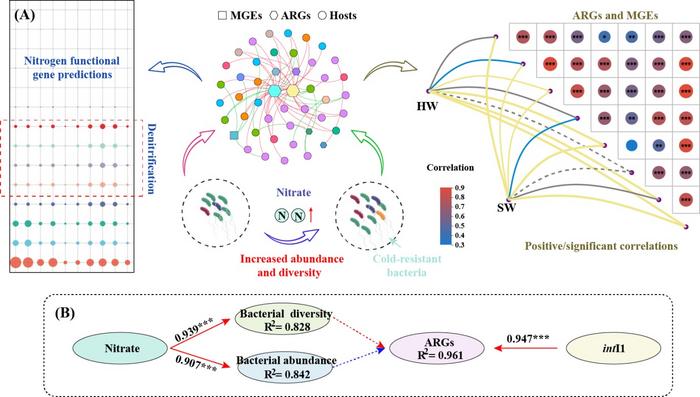Antibiotic resistance genes (ARGs) have been widely detected in water, sediment, gut and even the phycosphere of algae. In strong anthropogenic activity areas, antibiotic resistance caused by ARGs can pose a significant threat to human health. Despite the numerous published studies on the occurrence and distribution of ARGs in these areas, there is a dearth of literature on the presence and dispersal of ARGs in remote and pristine environments with limited antibiotic usage.

Credit: Chenxi Wu, et al.
Antibiotic resistance genes (ARGs) have been widely detected in water, sediment, gut and even the phycosphere of algae. In strong anthropogenic activity areas, antibiotic resistance caused by ARGs can pose a significant threat to human health. Despite the numerous published studies on the occurrence and distribution of ARGs in these areas, there is a dearth of literature on the presence and dispersal of ARGs in remote and pristine environments with limited antibiotic usage.
Qinghai Lake, located in the northeastern part of the Qinghai-Tibet Plateau, is the largest saltwater lake in mainland China. Notably, it is an important water body for maintaining ecological security. The typical geographical and humanistic features of the Qinghai Lake basin, especially in the northern region, are high altitude (more than 3,000 m), oxygen-deficient environment, low temperature, and sparse human population. Due to governmental protection and national nature reserve policies, the Qinghai Lake basin is less affected by anthropogenic activity. Nevertheless, it must be acknowledged that the Qinghai Lake basin is a closed watershed with no river outflow. As such, the lake can easily become a sink of ARGs from the watershed and surrounding rivers. In light of this unique geographical background, no prior investigations have explored the occurrence and transmission of ARGs under varied nutrient conditions within the Qinghai Lake basin.
To that end, a team of researchers in China investigated the microbial community and ARGs in two typical rivers of the western Qinghai Lake basin.
“We found that the microbial community was unique in the western Qinghai Lake basin,” shares Chenxi Wu, corresponding author of the study.“Specifically, cold-resistant Planomicrobium sp. was the predominant genus due to the low temperature.”
Furthermore, the team noted that although ARGs in the western Qinghai Lake basin were significantly lower than that in strong anthropogenic activity areas, a strong correlation between ARGs and intI1 indicated the potential rapid proliferation and spread of ARGs through cross- or co-selection if antibiotic pollution occurs in that area.
The team’s findings, published in the KeAi journal Water Biology and Security, emphasized the adaptation of bacteria to the environment and the facilitation of anthropogenic activity in the propagation of ARGs in natural environments.
###
Contact the author: Jia Jia & Chenxi Wu, Institute of Hydrobiology, Chinese Academy of Sciences, Wuhan, 430072, China, [email protected]; [email protected]
The publisher KeAi was established by Elsevier and China Science Publishing & Media Ltd to unfold quality research globally. In 2013, our focus shifted to open access publishing. We now proudly publish more than 100 world-class, open access, English language journals, spanning all scientific disciplines. Many of these are titles we publish in partnership with prestigious societies and academic institutions, such as the National Natural Science Foundation of China (NSFC).
Journal
Water Biology and Security
DOI
10.1016/j.watbs.2024.100249
Article Title
Characteristics of microbial communities and antibiotic resistance genes in typical rivers of the western Qinghai Lake basin
COI Statement
The authors declare that they have no known competing financial interests or personal relationships that could have appeared to influence the work reported in this paper. Chenxi Wu is an editorial board member for Water Biology and Security and was not involved in the editorial review or the decision to publish this article.




